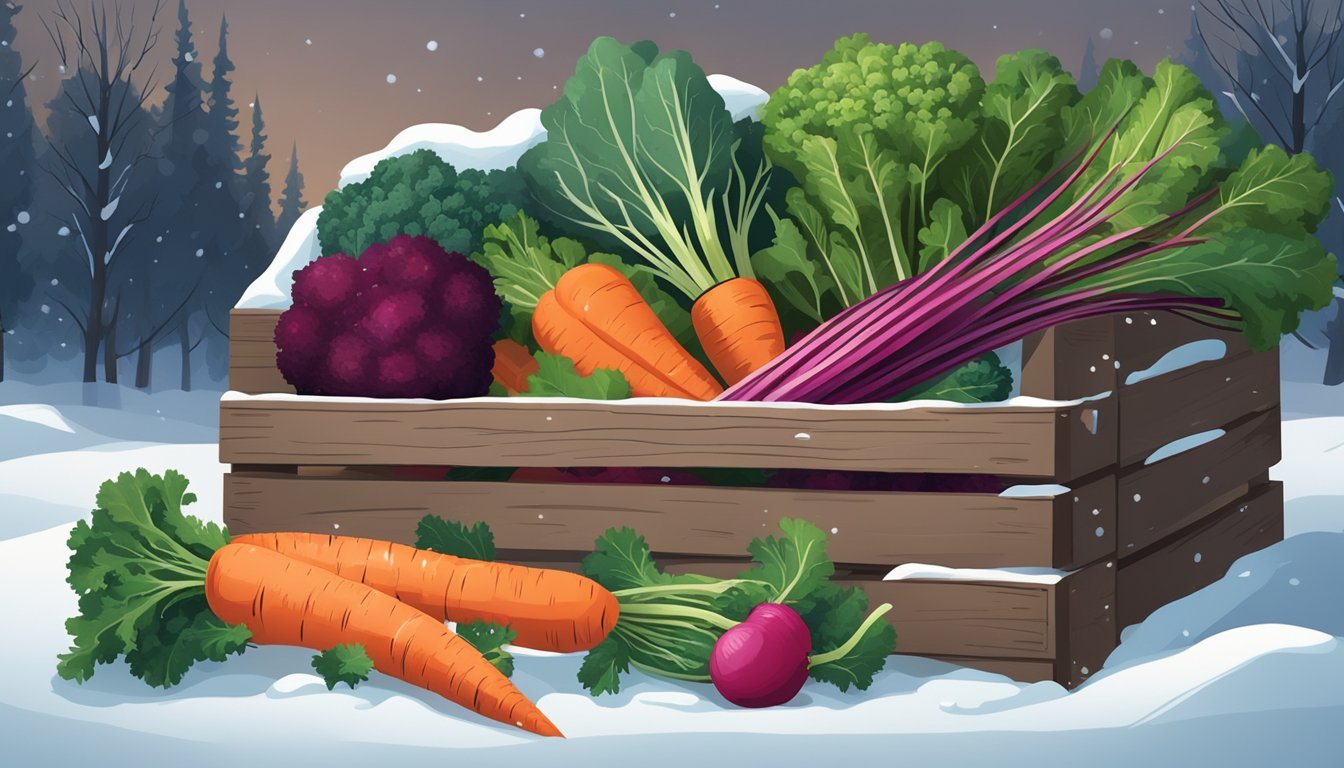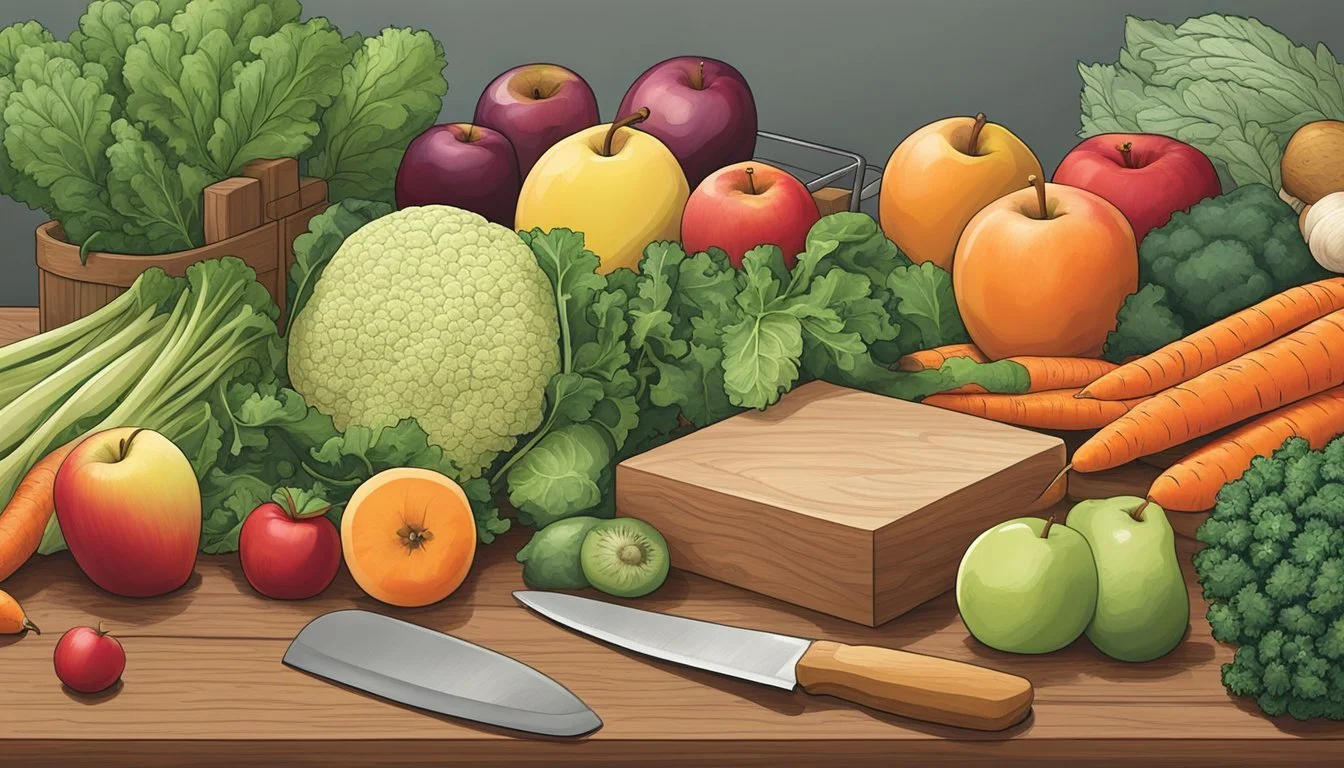Oregon Seasonal Fruit & Vegetables in February
A Guide to the Best Picks
This Article is Part of our Oregon Seasonal Fruit & Veg Calendar
February in Oregon is a time when the winter's chill is still present, but signs of the impending spring begin to emerge in the agricultural sector. As the cold month persists, local farmers and gardeners anticipate the last of the frost and prepare for the upcoming planting season. Despite the cooler temperatures, there is an array of seasonal produce available. Citrus fruits, such as lemons, limes, oranges, and grapefruits, reach their peak during these cooler months, bringing a splash of color and fresh flavors to the winter palette.
Oregon's climate and fertile soil allow for the year-round cultivation of various hardy vegetables. Root vegetables and leafy greens are commonly found in abundance during this time. Carrots, potatoes, and beets continue to be harvested, while leafy greens like kale, chard, and collard greens (how long do collard greens last?)withstand the cold, providing fresh options for winter nutrition. These crops are well-suited to the Oregon winter, often thriving in the colder weather and offering a fresh taste even when the ground is still thawing.
While February may not boast the variety of the summer or fall harvests, Oregon's seasonal fruits and vegetables at this time are a testament to the state's diverse agricultural capabilities. Farmers markets and local grocery stores showcase these seasonal offerings, encouraging consumers to make the most of the fresh, locally-sourced produce available during this period. The emphasis on seasonal eating not only supports local agriculture but also ensures that the fruits and vegetables consumed are at their optimal taste and nutritional value.
Understanding Oregon's Growing Seasons
In Oregon, the growing seasons vary across the region, giving rise to a diverse array of farm produce that shifts with the changing months. Certain crops thrive in the cool, wet winters, while others peak in the warm, dry summers, all influenced by the unique climates within the state's various zones.
Winter and Early Spring
During the cooler months of winter and early spring, Oregon's farms often provide crops that are hardy against the cold. February and March mark the time for late winter vegetables. Farmers may harvest over-wintered root vegetables, while cold frames and greenhouses allow for the cultivation of certain greens.
Transition to Spring Produce
As Oregon transitions into spring, the soil begins to warm, opening the field for a broader variety of produce. Early spring marks the planting season for several vegetables, while some of the winter crops reach their peak and are fresh on the market.
The Summer Bounty
Come June, July, and August, the summer months showcase Oregon's most abundant growing season. The warm temperatures and longer days are ideal for a range of fruits and vegetables. The region's berries and tender vegetables come into full swing and are celebrated throughout local markets.
Fall Harvests
As the season shifts into fall, Oregon's farms begin their harvest of heartier fare. Pumpkins and apples are iconic of this time, signaling the close of the growing season. The harvests continue until the first frosts, allowing a variety of produce to be stored for the winter months ahead.
Seasonal Vegetables in February
February in Oregon showcases a range of vegetables that thrive in the cooler temperatures. This month's bounty includes hearty root vegetables and tubers, a variety of cruciferous vegetables, and a selection of nutrient-rich leafy greens and stalks.
Root Vegetables and Tubers
Root crops such as potatoes and sweet potatoes are prime picks during February. They store well and offer versatility in the kitchen. Other root vegetables like carrots, which are known for their natural sweetness, parsnips with their earthy taste, and turnips featuring a slightly peppery flavor, are also readily available during this time.
Cruciferous Vegetables
The cruciferous family offers many options with cabbage being a standout choice for its durability and adaptability in various dishes. Broccoli, Brussels sprouts, and cauliflower are in their prime, delivering not only robust flavors but also an abundance of health benefits due to their high vitamin content.
Leafy Greens and Stalks
Leafy greens like kale and collard greens remain in season, known for their deep colors and nutrient density. Leeks, with their mild onion-like taste, and celery are also at their best, perfect for adding to soups and stews (What wine goes well with stews?). Additionally, chard provides a pop of color and a tender texture to a multitude of February dishes.
Seasonal Fruits for February
February in Oregon brings with it a variety of seasonal fruits that are ripe for the picking. Amid the chill of winter, certain fruits reach their peak and offer rich flavors and nutritional value.
Winter Fruits
During February, apples and pears are two of the prominent fruits that are still in season in Oregon. The cooler temperatures ensure that these fruits retain their crisp texture and sweet flavors.
Apples: Different varieties such as Fuji, Braeburn, and Gala may be available and are ideal for both fresh eating and cooking.
Pears: Varieties like Anjou and Bosc are common and known for their buttery flesh and versatility.
Citrus Varieties
February is also a notable time for citrus fruits, a category that includes a few different types that thrive during winter months.
Lemons: Perfect for adding a tangy zest to dishes or making lemonade.
Oranges: Navel oranges are sweet and juicy, fit for snacking or juicing.
Herbs and Flavor Enhancers
In the cool, yet not freezing temperatures of February in Oregon, growers take advantage of the resilience of certain herbs and alliums. This time of year is favorable for harvesting herbs that withstand the cold and for using alliums that have been overwintered or stored.
Hardy Herbs
Hardy herbs such as sage, rosemary, and thyme continue to thrive during Oregon's chilly winters. These herbs can often be harvested fresh during this time:
Sage offers a robust, earthy flavor perfect for savory dishes.
Rosemary is known for its fragrant aroma and pine-like flavor, commonly used in roasts and soups.
Thyme has a subtle, dry aroma with minty and lemony notes, versatile in many culinary applications.
Each of these herbs not only brings its distinct flavor profile to dishes but also boasts the capability to withstand colder temperatures, making them stalwarts of the winter herb garden.
Alliums
Alliums such as onions, garlic, shallots, and green onions provide foundational flavors for a wide array of dishes. Though not actively growing, stored varieties are an essential component of the seasonal larder:
Onions and Garlic: These staples, cured and stored from previous harvests, are indispensable for their depth of flavor in cooked dishes.
Shallots: Known for their milder taste, they are excellent both cooked and raw, bringing a subtle yet distinct flavor.
Green onions: These may be available if they have been protected in the garden, offering a fresh, sharp taste that suits both cooked meals (how long do cooked meals last?) and raw salads.
Together, these herbs and alliums form an essential flavor base for winter cuisine in Oregon, highlighting the region's capability to produce and make use of robust, flavorful plants even in the colder months.
Preparing Seasonal Dishes
In Oregon, February is a key month for savoring the last of winter's bounty and the earliest hints of spring. Cooking with seasonal produce ensures the freshest flavors while supporting local agriculture. Hearty soups and stews feature prominently in this chilly month, as do vibrant salads and side dishes that incorporate robust greens like spinach (What wine goes well with spinach?).
Soups and Stews
Soups and stews are ideal for incorporating a variety of February's seasonal vegetables. One can start with a vegetable broth (how long does vegetable broth last?) as a base and add chopped kale or spinach for a nutritional boost and rich green color. Root vegetables such as beets, which are available through February, also add earthiness and body to any stew.
Seasonal Soup Example
Broth: Vegetable or Chicken
Greens: Kale, Spinach
Vegetables: Carrots, Potatoes, Onions
Herbs: Thyme, Rosemary
Adding citrus zest or juice at the end of cooking can enliven flavors, with oranges being in season and at their peak during this time.
Salads and Side Dishes
February's crisp greens, such as spinach, are excellent for salads and side dishes that complement any meal. Spinach can be paired with slivers of in-season citrus fruit like oranges to create a fresh, bright salad. Lightly dress with an olive oil and lemon vinaigrette to complement the produce without overpowering it.
Salad Components
Greens: Spinach or Arugula
Fruits: Orange segments or Dried Cranberries (how long do dried cranberries last?)
Dressing: Olive oil, Lemon juice, Salt, Pepper
Side dishes might include roasted root vegetables, or a sauté of greens with garlic and a splash of vinegar. Using simple cooking methods like roasting or sautéing allows the true flavor of the vegetables to shine through.







